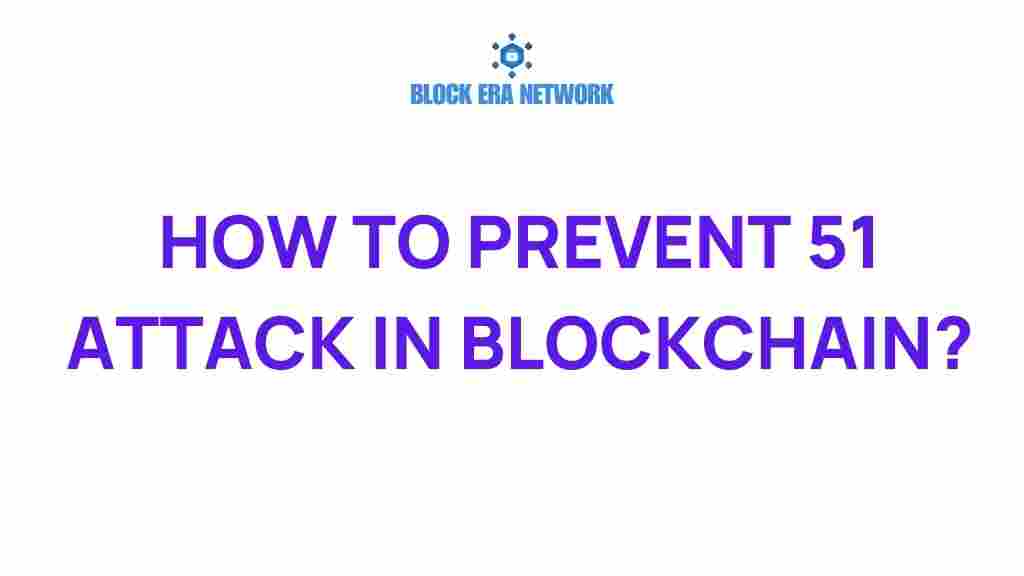Unraveling the Mystery: How to Prevent 51% Attacks in Blockchain
Blockchain technology has revolutionized the way we think about data integrity and security. However, it is not without its vulnerabilities. One significant threat is the 51% attack, which poses a major risk to blockchain security. In this article, we will explore what a 51% attack is, how it affects blockchain networks, and the strategies that can be employed to prevent such attacks while ensuring transaction integrity and maintaining decentralization.
Understanding the 51% Attack
A 51% attack occurs when a single entity or group gains control of more than 50% of a blockchain network’s mining power. This overwhelming control allows the attacker to manipulate the blockchain in several harmful ways:
- Double spending: The attacker can spend the same cryptocurrency more than once.
- Blocking transactions: They can prevent other users from confirming transactions.
- Reversing transactions: The attacker can invalidate transactions that have been confirmed.
Given the potential for abuse, understanding the implications of a 51% attack is crucial for maintaining cryptocurrency safety and protecting network integrity.
The Importance of Decentralization
Decentralization is one of the core principles of blockchain technology. It ensures that no single entity has control over the network, which is vital for preventing 51% attacks. When a blockchain is decentralized, power is distributed among many participants, making it much harder for any individual or group to gain the majority of mining power.
Consensus Mechanisms and Their Role in Security
Consensus mechanisms are protocols that consider a transaction as valid only when a certain number of nodes agree on it. Different blockchains use various consensus mechanisms, which can significantly influence their vulnerability to 51% attacks:
- Proof of Work (PoW): This is the original consensus mechanism used by Bitcoin. It requires miners to solve complex mathematical problems to validate transactions. While PoW can be secure, it is also resource-intensive and can lead to centralization if mining power accumulates in a few hands.
- Proof of Stake (PoS): In PoS, validators are chosen based on the number of coins they hold and are willing to “stake” as collateral. This mechanism encourages decentralization, as those with more coins have more influence, but it can also lead to wealth concentration.
- Delegated Proof of Stake (DPoS): This method allows stakeholders to vote for delegates who validate transactions on their behalf. While it can enhance efficiency, it risks creating a small number of powerful delegates.
- Proof of Authority (PoA): Validators are pre-approved and identified, which can enhance security but compromises decentralization.
Choosing the right consensus mechanism is critical for enhancing blockchain security and reducing susceptibility to 51% attacks.
Strategies for Preventing 51% Attacks
To mitigate the risk of a 51% attack, blockchain networks can implement several strategies:
- Increase Network Participants: The more miners or validators there are in a network, the harder it becomes for any single entity to gain majority control. Encouraging more participants through incentives can strengthen the network.
- Use Hybrid Consensus Mechanisms: Combining different consensus mechanisms can enhance security. For instance, integrating PoW with PoS can leverage the strengths of both systems.
- Implement Checkpoints: Regular checkpoints can be established within the blockchain to prevent the reversal of transactions beyond a certain point. This limits the effectiveness of a 51% attack.
- Monitor Network Activity: Continuous monitoring of network activity can help identify unusual patterns that may indicate a potential attack. Early detection can facilitate a swift response.
- Encourage Decentralized Mining Pools: Mining pools can consolidate resources, but they can also centralize power. Developing decentralized mining pools can distribute mining power more evenly across the network.
Step-by-Step Process for Enhancing Blockchain Security
To effectively enhance blockchain security against 51% attacks, follow this step-by-step process:
- Assess Current Vulnerabilities: Identify and analyze existing weaknesses in your blockchain infrastructure.
- Choose an Appropriate Consensus Mechanism: Based on your network’s needs, select a consensus mechanism that balances security, efficiency, and decentralization.
- Promote Community Engagement: Encourage more users to participate in the network by providing educational resources and incentives.
- Implement Security Protocols: Establish protocols for regular updates, security audits, and community reporting of suspicious activities.
- Regularly Review and Update Strategies: The threat landscape is constantly evolving. Regularly review and adjust your security measures to address new vulnerabilities.
Troubleshooting Common Issues
While implementing security measures, you may encounter some common issues. Here are troubleshooting tips:
- Low Participation Rates: If network participation is low, consider increasing incentives for miners or validators and launching educational campaigns.
- Difficulty in Transitioning Consensus Mechanisms: Transitioning to a new consensus mechanism can be complex. Ensure to communicate clearly with your community and outline the benefits of the new system.
- Increased Centralization: If you notice centralization trends, take immediate steps to promote decentralized mining and validate engagement.
Conclusion
51% attacks represent a significant threat to the integrity of blockchain networks, but understanding the mechanics behind these attacks is the first step in preventing them. By prioritizing decentralization and implementing robust consensus mechanisms, blockchain networks can enhance their security and maintain transaction integrity. Continuous monitoring, community engagement, and strategic updates are essential for ensuring cryptocurrency safety in an ever-evolving landscape.
For further reading on blockchain security and mechanisms, check out this comprehensive guide. To stay updated on the latest trends in cryptocurrency safety, visit CoinDesk.
This article is in the category Blockchain Basics and created by Block Era Network Team
